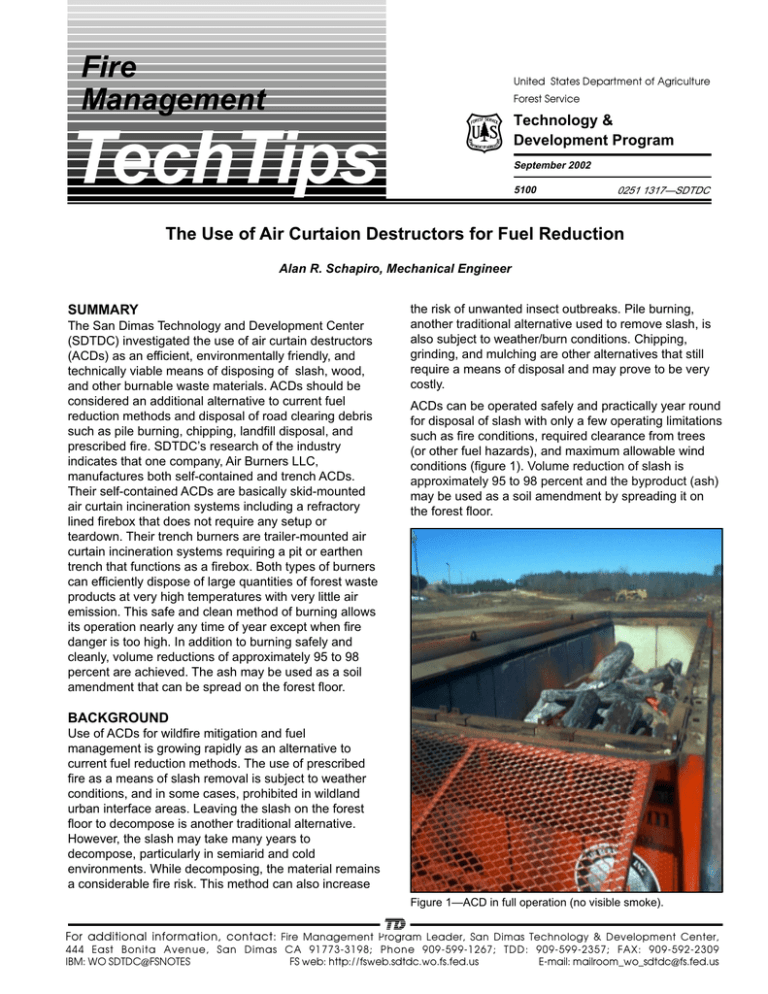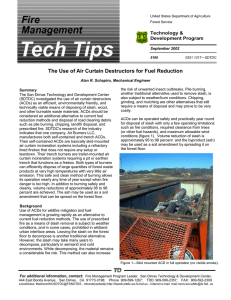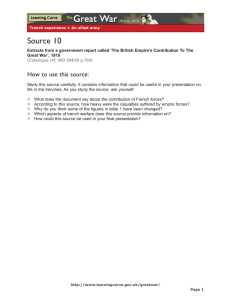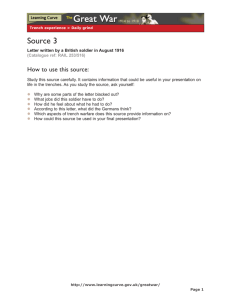TechTips Fire Management The Use of Air Curtaion Destructors for Fuel Reduction
advertisement

Fire Management United States Department of Agriculture Forest Service Technology & Development Program TechTips September 2002 5100 0251 1317—SDTDC The Use of Air Curtaion Destructors for Fuel Reduction Alan R. Schapiro, Mechanical Engineer SUMMARY The San Dimas Technology and Development Center (SDTDC) investigated the use of air curtain destructors (ACDs) as an efficient, environmentally friendly, and technically viable means of disposing of slash, wood, and other burnable waste materials. ACDs should be considered an additional alternative to current fuel reduction methods and disposal of road clearing debris such as pile burning, chipping, landfill disposal, and prescribed fire. SDTDC’s research of the industry indicates that one company, Air Burners LLC, manufactures both self-contained and trench ACDs. Their self-contained ACDs are basically skid-mounted air curtain incineration systems including a refractory lined firebox that does not require any setup or teardown. Their trench burners are trailer-mounted air curtain incineration systems requiring a pit or earthen trench that functions as a firebox. Both types of burners can efficiently dispose of large quantities of forest waste products at very high temperatures with very little air emission. This safe and clean method of burning allows its operation nearly any time of year except when fire danger is too high. In addition to burning safely and cleanly, volume reductions of approximately 95 to 98 percent are achieved. The ash may be used as a soil amendment that can be spread on the forest floor. the risk of unwanted insect outbreaks. Pile burning, another traditional alternative used to remove slash, is also subject to weather/burn conditions. Chipping, grinding, and mulching are other alternatives that still require a means of disposal and may prove to be very costly. ACDs can be operated safely and practically year round for disposal of slash with only a few operating limitations such as fire conditions, required clearance from trees (or other fuel hazards), and maximum allowable wind conditions (figure 1). Volume reduction of slash is approximately 95 to 98 percent and the byproduct (ash) may be used as a soil amendment by spreading it on the forest floor. BACKGROUND Use of ACDs for wildfire mitigation and fuel management is growing rapidly as an alternative to current fuel reduction methods. The use of prescribed fire as a means of slash removal is subject to weather conditions, and in some cases, prohibited in wildland urban interface areas. Leaving the slash on the forest floor to decompose is another traditional alternative. However, the slash may take many years to decompose, particularly in semiarid and cold environments. While decomposing, the material remains a considerable fire risk. This method can also increase Figure 1—ACD in full operation (no visible smoke). For additional information, contact: Fire Management Program Leader, San Dimas Technology & Development Center, 444 East Bonita Avenue, San Dimas CA 91773-3198; Phone 909-599-1267; TDD: 909-599-2357; FAX: 909-592-2309 IBM: WO SDTDC@FSNOTES FS web: http://fsweb.sdtdc.wo.fs.fed.us E-mail: mailroom_wo_sdtdc@fs.fed.us The ACDs manufactured by Air Burners LLC have been used worldwide for several types of applications. They are used in forest fuel management and wildfire mitigation efforts, in the construction industry to reduce debris from land clearing and demolition operations, and at landfill sites to maximize costly space by reducing wood waste and similar burnable waste streams. They are also used in disaster recovery for clearing the aftermath from storms or floods. DESCRIPTION The main operating principle of the ACD is the high velocity air (curtain) blown across and into the upper portion of the combustion chamber (figure 2). This powerful curtain of air has two effects. First, the high volume of air causes overoxygenation of the fire, and secondly the high velocity airflow over the combustion chamber entraps particulates (smoke), which then completes combustion in the combustion chamber, thus limiting emissions and smoke. The high turbulence along with increased combustion time and temperatures in excess of 1,800 oF results in complete combustion and significantly reduced air emissions. Reduced air emissions lower impact on nearby residents, smoke sensitive individuals, and decrease smoke-related inversions during fall and winter. In addition, the high temperatures and oxygen-rich environment burn everything from green fuels to red slash. Figure 2—Air Burner 1. Air curtain burner manifold and nozzles directing high velocity air flow in refractory lined box or earthen trench. 2. Refractory lined wall for self contained ACD or earthen wall for trench ACD. 3. Waste material to be burned. 4. Air Flow forms a high velocity “curtain” over fire. 5. Continuous airflow over-oxygenates the fire, creating higher temperatures and thereby a more clean and complete burn. EQUIPMENT Air Burners LLC manufactures two types of ACDs: selfcontained skid-mounted firebox systems that do not require any setup or teardown; and trench burners that require setup and an earthen pit or trench which functions as the firebox. Skid-Mounted Systems The skid-mounted ACD as shown in figure 3, is a selfcontained system that includes a refractory walled firebox, diesel engine power plant, mechanical drive system, blower fan, and fuel tank. These ACDs are engineered to be transportable by a lowboy or similar drop-deck trailer. The transportability increases the flexibility of bringing the ACD to the wood waste source, rather than hauling the waste to a fixed location for processing. These ACDs are ready for use as soon as they are offloaded at the jobsite. The refractory lined firebox allows for controlled burning without the need for an earthen pit or trench. The forward equipment deck shown in figure 3 supports the diesel engine, the fuel tank, the direct drive system to operate the fan, and the fan. An air nozzle manifold is mounted on one side of the firebox. The wood waste is loaded over the top of the ACD on the side opposite the manifold (figure 4). Figure 3—Skid mounted ACD in full operation (no visible smoke). Skid-mounted systems are designed and constructed to optimize the air curtain concept. High velocity air is blown across and down at an optimum angle into the pit creating the air curtain on top and a rotational turbulence within the firebox. The high velocity air creating the rotational turbulence provides an oxygenenriched environment in the combustion zone that accelerates the combustion process (similar to the effect of fanning a fire). The temperature within the firebox is usually above 2,000 oF. The high velocity air 2 contain a firebox. The manifold sections are assembled and placed along the trench edge. Carrier pipe sections are assembled to carry the air from the power plant to the manifold, thereby keeping the trailer-mounted components clear of damaging heat generated from the burning operations (figure 6). Burning operations can usually run until the ash in the trench needs to be removed or a new trench is needed. Air Burners LLC manufactures several trailer-mounted trench systems with burn rates ranging from 5 to 14 tons per hour. These units can also be leased. FIREBOX VS TRENCH BURNER The self-contained firebox burners eliminate guesswork regarding the size of the fire area. These above-ground units avoid problems with the water table, rocks, and roots and allow for easier ash removal. The real minus for these units is their size. The smallest ACDs weigh over 20,000 pounds. So dragging it around in soft soil can be difficult. While the smaller units will fit on a Figure 4—Loading fuel into ACD (full operation). over the firebox creates an air curtain that traps unburned particulate until it is completely consumed. Nearly complete combustion is achieved with minimal amounts of escaped particulates, virtually eliminating smoke. Vertical refractory walls aid in the combustion process by retaining and reflecting the high temperatures generated within the firebox. The combustion process reduces the wood waste by approximately 98 percent, leaving about 2 percent in volume as residual ash. Twin refractory lined panel doors at the rear of the firebox allow for ash removal. The unit has no bottom and can be dragged on its skids with the rear door panels open for dumping ash. The skids and durability of the unit allow it to be dragged around the site for repositioning or from site to site depending upon the terrain and distance to be moved. The ash may be left in place, disposed of, or used as a soil amendment by mixing it with the soil at the site or other locations. Figure 5—Trailer mounted Trench Burner System. Air Burners LLC manufactures several skid-mounted systems with burn rates ranging from 1 to 15 tons per hour. The larger units are more difficult to transport or move around the site. Due to their size, special permits are required for transporting over roads. Systems can be customized to meet specific needs. The standard units can also be leased. Trench Burner Systems The trench burner systems are trailer-mounted selfcontained air curtain incineration systems consisting of a power plant, mechanical drive system, blower fan, and fuel tank (figure 5). All of the components are either mounted to or stored on the trailer. An earthen trench must be constructed since the trench burners do not Figure 6—Trench Burner. 3 standard equipment trailer, the larger units are oversized loads for most roads. So the logistics are more complicated than towing a trench burner. 100-foot clearance around the ACD. Barring extremely high winds there is little chance of large embers escaping the trench or firebox and burning beyond the clear area. Very small embers can escape, but generally burn completely before they hit the ground. Having an engine and crew onsite further reduces the risk of fire. A patrol of the area may reduce the clear area requirements and burn condition limitations. ACDs should not be operated if the fire danger is too high or if people or animals are likely to fall into the pit or climb up on the box. Should conditions require shutdown, the fire could be extinguished in 10 to 20 minutes. Safety should always be the number one operational consideration. The trench burner can be easily towed behind a truck to the jobsite. These units will handle more uneven terrain than the fireboxes and can be mobilized quickly. The trench allows the operator to easily see the fire and load the pit without the need to raise the fuel up over the wall. The real minus for the trench burner is in the construction of the trench. The trench must be dug correctly or the efficiency of the ACD goes down, increasing emissions and decreasing thru-put (burn rate). If the trench is omitted or too shallow, the principle of the air curtain is lost. Ground and soil conditions become a big factor. A high water table can create flooding in the trench and cause trench walls to lose integrity if the soil is too soft. Additional safety factors also must be considered. Precautions must be taken to alert personnel to the pit’s location to avoid inadvertently falling in or perching heavy loading equipment too near the edge of the pit causing the walls to collapse. U.S. Environmental Protection Agency regulations for New Source Performance Standards (NSPS) requires that ACDs operate below opacity limits of 35 percent during the initial 30-minute startup and 10 percent during operation (6-minute average), provided the material burned is restricted to 100 percent wood waste, clean lumber, and/or yard waste. Air Burner ACDs operate well below these limits in contrast to open burning which averages between 60 to 80 percent opacity. OPERATION Skid-mounted or trench burner ACDs are simple, easy, and almost identical to operate. ACD operations follow three stages: startup, full operation, and burndown. For startup, the trench or firebox is partially loaded with layers of fine and easily burnable forest slash. An accelerant (typically diesel fuel) is applied over the layers and covered with heavier logs to just under the manifold. Fusees could be used for ignition. The fan is started once the heavier materials burn, and the fan speed is gradually increased to full capacity. Smoke will be produced during startup, but will decrease as the fan speed increases and the process approaches full operation. Startup burning takes about 1 hour and is complete when a base of hot coals and burning material is established. During full operation, slash is fed to the fire at a steady rate using a front-end loader or an excavator with a bucket and thumb. The last stage, burndown, typically takes about 1 to 2 hours. The air is slowly decreased as the last load burns down. After burndown, hot coals may remain for several days under an insulating blanket of ash. The ash may be left in place, disposed of, or used as a soil amendment by mixing it with the soil onsite or at other locations. SDTDC EVALUATION SDTDC is currently planning to operate a skid-mounted unit for evaluation purposes in Fall 2002 at a site within national forest lands. Data will be collected on aspects such as mobility, durability, and operability to develop Forest Service recommendations and standards for operation. This information will be published during FY 2003. CONCLUSIONS ACDs should be considered when evaluating alternatives to current fuel reduction methods in urban interface areas. ACDs may not be as cost competitive in areas where broadcast and pile burning are acceptable. Potential advantages to ACDs include: • Produces lower smoke emissions compared to pile or broadcast burning. • Burns a greater variety of materials from green fuel to red slash. Skid-mounted ACDs are designed to run for approximately 24 hours before the ash needs to be removed. Long burns are generally more efficient (having lower emissions) than shorter burns. The efficiency starts to drop once the ash pile reaches approximately 1/4 to 1/3 the depth of the firebox or pit. For safe operation, the manufacturer recommends a • Reduces fire risk and outbreak of insect problems. • Operates with fewer restrictions on weather and burn conditions. • Residents in urban interface areas are more 4 willing to accept ACD use and remove wood waste and slash fuel hazards around their homes if offered free disposal. ABOUT THE AUTHOR Alan Schapiro, a licensed professional engineer in the State of California, obtained both a bachelor’s degree in mechanical engineering and a master’s degree in engineering from Cornell University. He has 20-plus years of engineering and project management experience in the development, design, startup, and operation of oil/gas, coal, nuclear, and alternate/ renewable electric generation power plants. Alan is a project leader in the Fire and Aviation program responsible for air curtain destructor applications, fire engine development and testing, and foam proportioner testing. He also has responsibilities in other program areas such as engineering roads technology, forest management, and recreation. • The fire is contained and easily and quickly extinguished, if necessary. INFORMATION For further information regarding ACDs manufactured by Air Burners LLC, contact: Brian O’Connor or Norbert Fuhrmann Air Burners LLC 4390 Cargo Way Palm City, FL 34990 888–566–3900 or 772–220–7303 www.airburners.com Approximate English to Metric System Conversion Factors To Change To pounds tons kilograms kilograms Multiply by 0.454 907.2 Temperature Conversion of Units °C = (°F – 32) / 1.8 5 Information contained in this document has been developed for the guidance of employees of the Forest Service, United States Department of Agriculture (USDA), its contractors, and cooperating Federal and State agencies. The USDA assumes no responsibility for the interpretation or use of this information by other than its own employees. The use of trade, firm, or corporation names is for the information and convenience of the reader. Such use does not constitute an official evaluation, conclusion, recommendation, endorsement, or approval of any product or service to the exclusion of others that may be suitable. The U.S. Department of Agriculture (USDA) prohibits discrimination in all its programs and activities on the basis of race, color, national origin, sex, religion, age, disability, political beliefs, sexual orientation, or marital or family status. (Not all prohibited bases apply to all programs.) Persons with disabilities who require alternative means for communication of program information (Braille, large print, audiotape, etc.) should contact USDA’s TARGET Center at (202) 720-2600 (voice and TDD). To file a complaint of discrimination, write USDA, Director, Office of Civil Rights, Room 326-W, Whitten Building, 1400 Independence Avenue, SW, Washington, D.C. 20250-9410 or call (202) 720-5964 (voice and TDD). USDA is an equal opportunity provider and employer.





